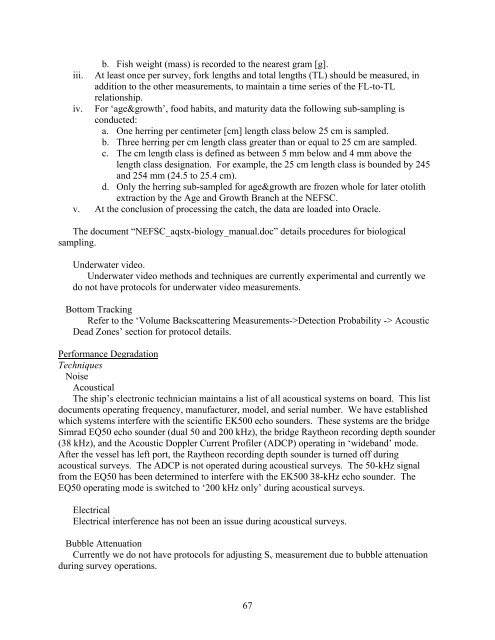NOAA Protocols for Fisheries Acoustics Surveys and Related ...
NOAA Protocols for Fisheries Acoustics Surveys and Related ...
NOAA Protocols for Fisheries Acoustics Surveys and Related ...
You also want an ePaper? Increase the reach of your titles
YUMPU automatically turns print PDFs into web optimized ePapers that Google loves.
. Fish weight (mass) is recorded to the nearest gram [g].<br />
iii. At least once per survey, <strong>for</strong>k lengths <strong>and</strong> total lengths (TL) should be measured, in<br />
addition to the other measurements, to maintain a time series of the FL-to-TL<br />
relationship.<br />
iv. For ‘age&growth’, food habits, <strong>and</strong> maturity data the following sub-sampling is<br />
conducted:<br />
a. One herring per centimeter [cm] length class below 25 cm is sampled.<br />
b. Three herring per cm length class greater than or equal to 25 cm are sampled.<br />
c. The cm length class is defined as between 5 mm below <strong>and</strong> 4 mm above the<br />
length class designation. For example, the 25 cm length class is bounded by 245<br />
<strong>and</strong> 254 mm (24.5 to 25.4 cm).<br />
d. Only the herring sub-sampled <strong>for</strong> age&growth are frozen whole <strong>for</strong> later otolith<br />
extraction by the Age <strong>and</strong> Growth Branch at the NEFSC.<br />
v. At the conclusion of processing the catch, the data are loaded into Oracle.<br />
The document “NEFSC_aqstx-biology_manual.doc” details procedures <strong>for</strong> biological<br />
sampling.<br />
Underwater video.<br />
Underwater video methods <strong>and</strong> techniques are currently experimental <strong>and</strong> currently we<br />
do not have protocols <strong>for</strong> underwater video measurements.<br />
Bottom Tracking<br />
Refer to the ‘Volume Backscattering Measurements->Detection Probability -> Acoustic<br />
Dead Zones’ section <strong>for</strong> protocol details.<br />
Per<strong>for</strong>mance Degradation<br />
Techniques<br />
Noise<br />
Acoustical<br />
The ship’s electronic technician maintains a list of all acoustical systems on board. This list<br />
documents operating frequency, manufacturer, model, <strong>and</strong> serial number. We have established<br />
which systems interfere with the scientific EK500 echo sounders. These systems are the bridge<br />
Simrad EQ50 echo sounder (dual 50 <strong>and</strong> 200 kHz), the bridge Raytheon recording depth sounder<br />
(38 kHz), <strong>and</strong> the Acoustic Doppler Current Profiler (ADCP) operating in ‘wideb<strong>and</strong>’ mode.<br />
After the vessel has left port, the Raytheon recording depth sounder is turned off during<br />
acoustical surveys. The ADCP is not operated during acoustical surveys. The 50-kHz signal<br />
from the EQ50 has been determined to interfere with the EK500 38-kHz echo sounder. The<br />
EQ50 operating mode is switched to ‘200 kHz only’ during acoustical surveys.<br />
Electrical<br />
Electrical interference has not been an issue during acoustical surveys.<br />
Bubble Attenuation<br />
Currently we do not have protocols <strong>for</strong> adjusting S v measurement due to bubble attenuation<br />
during survey operations.<br />
67
















